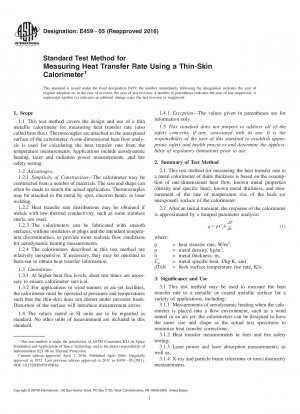ASTM E459-05(2016)
Standard Test Method for Measuring Heat Transfer Rate Using a Thin-Skin Calorimeter
- Standard No.
- ASTM E459-05(2016)
- Release Date
- 2005
- Published By
- American Society for Testing and Materials (ASTM)
- Status
- Replace By
- ASTM E459-22
- Latest
- ASTM E459-22
- Scope
3.1 This test method may be used to measure the heat transfer rate to a metallic or coated metallic surface for a variety of applications, including:
3.1.1 Measurements of aerodynamic heating when the calorimeter is placed into a flow environment, such as a wind tunnel or an arc jet; the calorimeters can be designed to have the same size and shape as the actual test specimens to minimize heat transfer corrections;
3.1.2 Heat transfer measurements in fires and fire safety testing;
3.1.3 Laser power and laser absorption measurements; as well as,
3.1.4 X-ray and particle beam (electrons or ions) dosimetry measurements.
3.2 The thin-skin calorimeter is one of many concepts used to measure heat transfer rates. It may be used to measure convective, radiative, or combinations of convective and radiative (usually called mixed or total) heat transfer rates. However, when the calorimeter is used to measure radiative or mixed heat transfer rates, the absorptivity and reflectivity of the surface should be measured over the expected radiation wavelength region of the source.
3.3 In 4.6 and 4.7, it is demonstrated that lateral heat conduction effects on a local measurement can be minimized by using a calorimeter material with a low thermal conductivity. Alternatively, a distribution of the heat transfer rate may be obtained by placing a number of thermocouples along the back surface of the calorimeter.
3.4 In high temperature or high heat transfer rate applications, the principal drawback to the use of thin-skin calorimeters is the short exposure time necessary to ensure survival of the calorimeter such that repeat measurements can be made with the same sensor. When operation to burnout is necessary to obtain the desired heat flux measurements, thin-skin calorimeters are often a good choice because they are relatively inexpensive to fabricate.
1.1 This test method covers the design and use of a thin metallic calorimeter for measuring heat transfer rate (also called heat flux). Thermocouples are attached to the unexposed surface of the calorimeter. A one-dimensional heat flow analysis is used for calculating the heat transfer rate from the temperature measurements. Applications include aerodynamic heating, laser and radiation power measurements, and fire safety testing.
1.2 Advantages:
1.2.1 Simplicity of Construction—The calorimeter may be constructed from a number of materials. The size and shape can often be made to match the actual application. Thermocouples may be attached to the metal by spot, electron beam, or laser welding.
1.2.2 Heat transfer......
ASTM E459-05(2016) history
- 2022 ASTM E459-22 Standard Test Method for Measuring Heat Transfer Rate Using a Thin-Skin Calorimeter
- 2005 ASTM E459-05(2016) Standard Test Method for Measuring Heat Transfer Rate Using a Thin-Skin Calorimeter
- 2005 ASTM E459-05(2011) Standard Test Method for Measuring Heat Transfer Rate Using a Thin-Skin Calorimeter
- 2005 ASTM E459-05 Standard Test Method for Measuring Heat Transfer Rate Using a Thin-Skin Calorimeter
- 1997 ASTM E459-97 Standard Test Method for Measuring Heat Transfer Rate Using a Thin-Skin Calorimeter

Copyright ©2024 All Rights Reserved